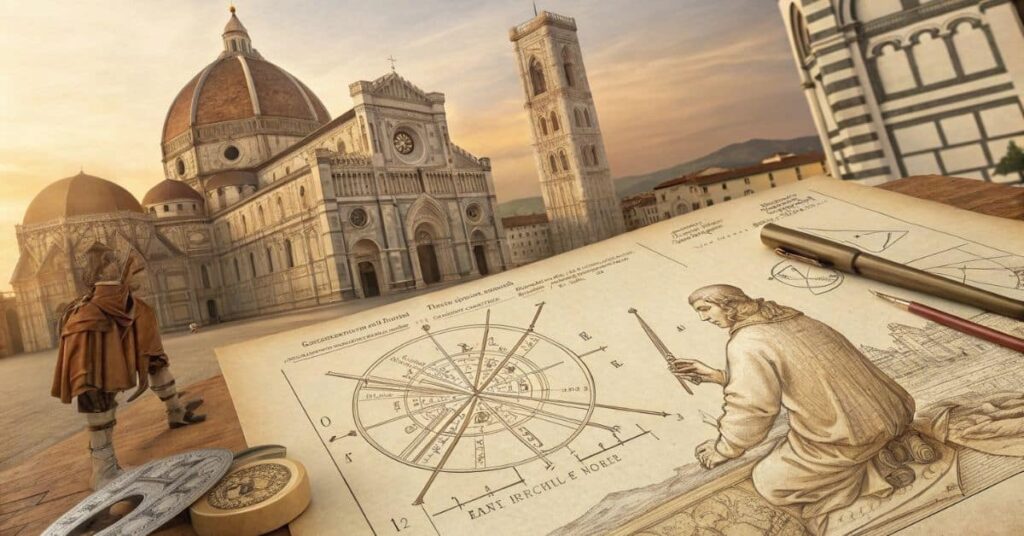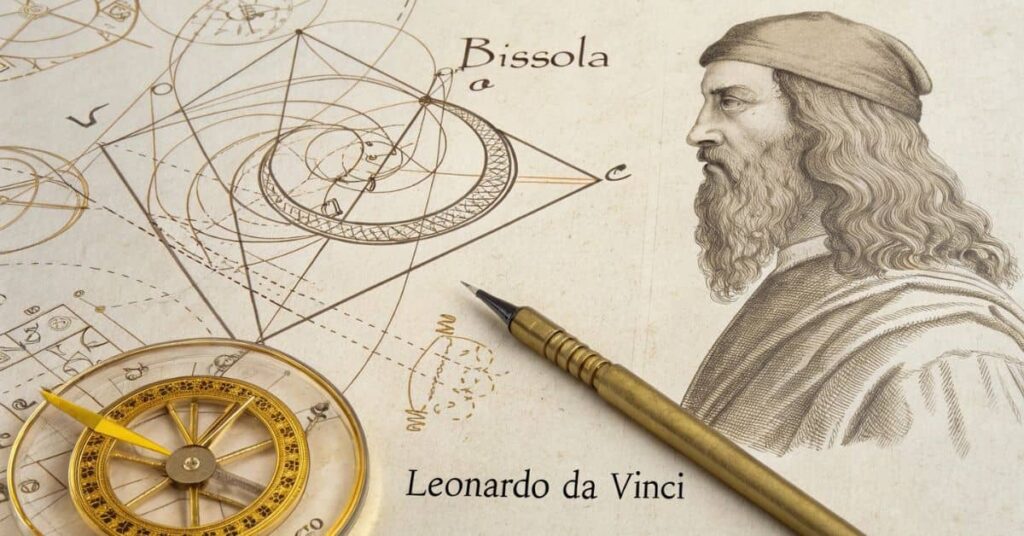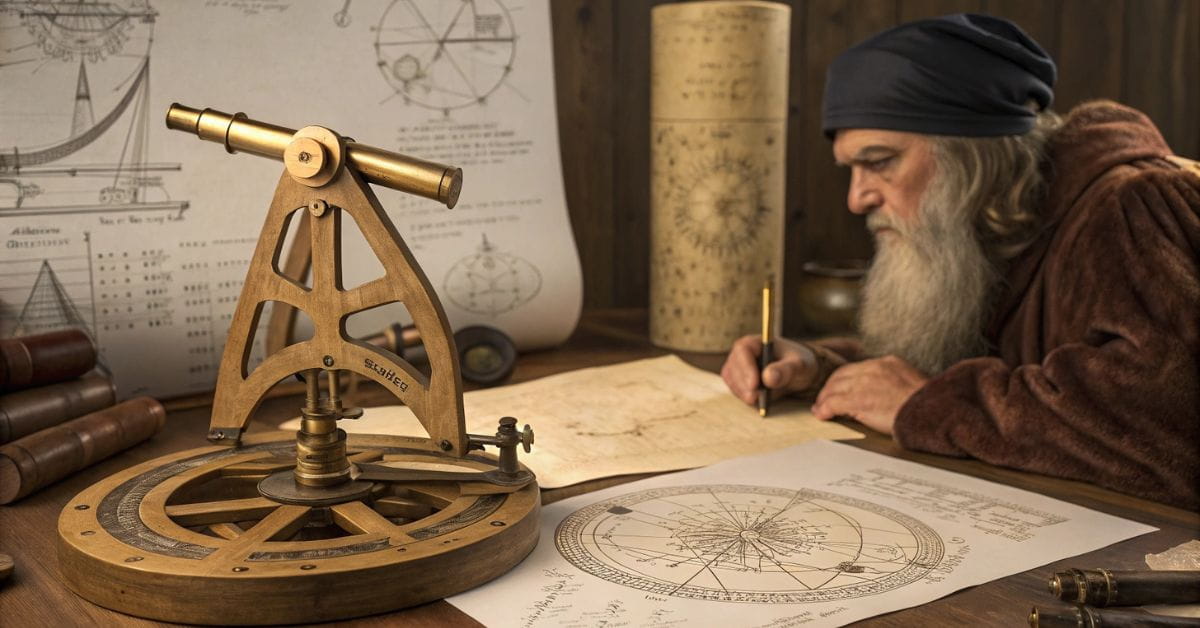Leonardo da Vinci, a brilliant artist and inventor, created many groundbreaking tools, one of which was the bussola to measure angles within a circle. This tool was designed to enhance precision in various fields, including architecture, mechanical design, and art. His passion for geometry and measurement led to the development of this instrument, which helped him create accurate and well-proportioned designs.
The bussola was not just a simple measuring device; it was a revolutionary tool that combined scientific principles with artistic techniques. It allowed for precise angular calculations, making it valuable for Renaissance-era innovations. Understanding this invention gives us deeper insight into da Vinci’s genius and how he bridged the gap between science and creativity.
Introduction to Leonardo da Vinci’s Bussola
Leonardo da Vinci’s work was deeply rooted in observation, analysis, and precision. His bussola to measure angles within a circle was an essential tool that enabled him to achieve accuracy in both his artistic and scientific projects. Whether he was designing architectural structures or sketching human proportions, the bussola played a crucial role in ensuring correctness.
This measuring instrument was far ahead of its time and demonstrated da Vinci’s mastery of mathematics and engineering. It showcased his ability to create tools that could be applied across various fields, proving that his innovations were not limited to art but extended to practical problem-solving as well.
Read Also: BetterThisCosmos Post BetterThisWorld – A New Era of Collaboration, Creativity, and Tech Innovation!
The Importance of Measuring Angles in the Renaissance
The Renaissance was a period of great intellectual and artistic growth, where precision and accuracy became essential in many disciplines. From astronomy to architecture, measuring angles was a critical aspect of ensuring that structures were stable and visually balanced. Artists used geometric principles to create perspective in their paintings, while engineers relied on mathematical calculations to design strong and durable buildings.

During this time, measuring instruments like da Vinci’s bussola played a vital role in advancing knowledge and improving design techniques. Without precise measurement tools, Renaissance artists and architects would have struggled to achieve the level of detail and accuracy seen in their works.
Leonardo da Vinci’s Approach to Geometry and Measurement
- Leonardo da Vinci was deeply interested in mathematical principles and their real-world applications. He studied ancient mathematicians like Euclid and Vitruvius, integrating their theories into his inventions.
- His knowledge of geometry enabled him to create tools that enhanced precision in various fields, including painting and engineering. His designs reflected a deep understanding of mathematical accuracy.
- By using precise measurements, he improved the realism of his artwork and the efficiency of his mechanical designs. His ability to merge science with art set him apart from his contemporaries.
- His approach to measurement was not just about calculations but focused on harmony and balance. These principles were essential in both art and science during the Renaissance, influencing future innovations.
What is a Bussola?
A bussola is an Italian term that generally refers to a compass or measuring instrument. In the context of da Vinci’s invention, it was a specialized tool designed to measure angles within a circle. It functioned similarly to a protractor but was more advanced, featuring a rotating mechanism and a scale for precise calculations.
Unlike modern protractors, which are static, da Vinci’s bussola allowed for dynamic angle measurements. This made it particularly useful in fields that required precise calculations, such as architecture, mechanical design, and cartography.
The Design and Mechanism of Da Vinci’s Bussola
Circular Base with Marked Divisions
The bussola to measure angles within a circle featured a circular base with precisely marked divisions. These markings allowed for highly accurate angular readings, making it easy to measure even the smallest angles with precision.
Central Pivot for Smooth Rotation
A central pivot point was incorporated into the design, enabling smooth rotation and fine adjustments. This feature allowed users to align the measuring arms with ease, ensuring accurate calculations for various applications.
Adjustable Arms for Precision Alignment
The bussola’s adjustable arms could be aligned with specific points on a circle’s circumference. This flexibility helped in measuring angles quickly and efficiently, making it a valuable tool for da Vinci’s architectural and engineering designs.
Graduated Scale for Accurate Measurements
A graduated scale was integrated into the device to enhance measurement accuracy. By combining this scale with the adjustable arms, the bussola provided precise angular readings, helping da Vinci achieve balance in his technical and artistic works.
How the Bussola Works
The bussola was used by placing its pivot point at the center of a circle and aligning its arms with the points being measured. The angle between these points could then be read from the scale, providing an accurate measurement. This method ensured consistency in geometric calculations, making it a reliable tool for professionals in various fields.
With its simple yet effective design, the bussola allowed users to perform complex angle measurements without the need for advanced mathematical calculations. It was a practical tool that combined ease of use with high precision, making it invaluable in both artistic and scientific applications.
Applications of the Bussola in Da Vinci’s Work
- In painting, the bussola helped da Vinci achieve accurate perspective, adding depth and realism to his compositions.
- His famous artworks, like The Last Supper, benefited from precise geometric calculations made possible by the bussola.
In architecture, it was used to design buildings and bridges with accurate angular measurements for symmetry and stability. - In engineering, the bussola helped in creating mechanical devices with precise proportions, improving functionality.
Comparison of Da Vinci’s Bussola with Modern Measuring Instruments
| 🔷 Aspect | 🏛 Da Vinci’s Bussola | 🚀 Modern Measuring Tools |
| Design | Circular base with a pivot for precise movement. | Simple protractors & digital theodolites with lasers. |
| Functionality | Used in art, architecture, and engineering. | Applied in construction, surveying, and navigation. |
| Accuracy | Adjustable arms for fine angular measurement. | Digital tools use GPS and lasers for precision. |
| Innovation | A groundbreaking invention ahead of its time. | Built on da Vinci’s principles with modern upgrades. |
Influence of Da Vinci’s Bussola on Modern Engineering and Science
Da Vinci’s bussola influenced many modern fields, particularly engineering, architecture, and navigation. The ability to measure angles accurately was a game-changer in construction, allowing for better planning and execution of large-scale projects. Even today, engineers use instruments based on the same principles that da Vinci employed.
The field of cartography also benefited from da Vinci’s innovations, as accurate angle measurement was essential for creating reliable maps. By developing tools like the bussola, da Vinci contributed to advancements that continue to shape modern science and technology.
Mathematical Principles Behind the Bussola
Euclidean Geometry for Angular Precision
The bussola relied on Euclidean geometry, which focuses on angles, circles, and proportions. This mathematical foundation ensured that measurements were accurate, making it a valuable tool for both artistic and engineering applications.
Trigonometric Functions for Calculations
The device incorporated trigonometry, utilizing sine, cosine, and tangent functions for precise angle measurements. This allowed da Vinci to perform complex calculations essential for designing architectural structures and mechanical inventions.

Golden Ratio for Harmony in Design
Da Vinci’s bussola was linked to the golden ratio, a principle found in nature, art, and architecture. By using this ratio, he maintained balance and harmony in his designs, ensuring aesthetic and structural perfection.
Measurement Accuracy for Engineering & Art
The bussola provided unparalleled accuracy, blending mathematics with creativity. Its ability to measure angles precisely contributed to da Vinci’s innovations in painting, engineering, and mechanics, influencing future generations.
FAQs About Da Vinci’s Bussola
What was the purpose of da Vinci’s bussola?
It was used to measure angles accurately for applications in art, architecture, and engineering, ensuring precise calculations.
How did the bussola improve perspective in paintings?
It helped da Vinci measure angles accurately, allowing him to create realistic depth and proportion in his artwork.
Is the original bussola still available today?
No original remains, but reconstructions based on da Vinci’s sketches have been created by historians and engineers.
How does da Vinci’s bussola compare to modern tools?
It functioned similarly to modern protractors and theodolites but was more advanced for its time, allowing for highly accurate measurements.
Conclusion
Leonardo da Vinci’s bussola to measure angles within a circle was an incredible invention that showcased his mastery of mathematics and engineering. By merging science with art, he developed a tool that improved accuracy in various fields, from painting to construction. His legacy continues to inspire modern innovations, proving that his genius remains relevant even today.
Read Also:




